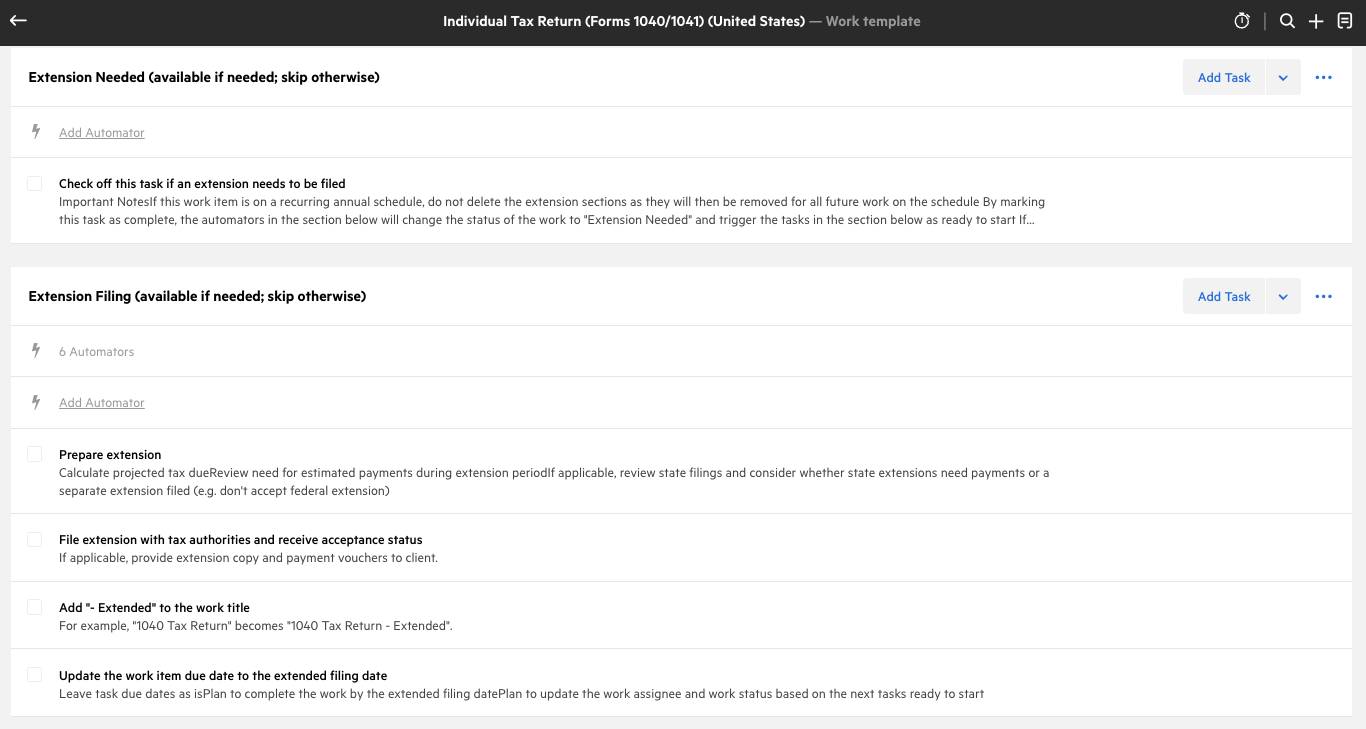Simplify filing with free templates for form 1040 and 1041 preparation
Tax season doesn’t have to be a nightmare if you use the right tools and process. Begin with this tax template and automation tips.

The ever-changing regulations, the mountains of paperwork, the time constraints–filing taxes for clients is often a dreaded challenge that leaves accounting professionals feeling like they're drowning.
There’s a reason why it’s called the busy season.
But the good news is: a tax template can toss you a lifeline.
The right tax templates standardize and automate important tax processes so that firms can boost tax season productivity, increase client satisfaction, and maximize profitability during crunch time.
Individual tax return template for forms 1040/1041
Karbon’s Individual Income Tax Return template provides US firms with an end-to-end process for supporting tax returns for a walk-in and new clients, including guidelines for more complicated returns.
It streamlines the process for completing tax returns (form 1040) and estates/trusts (form 1041).
👇 Download for free
Using the right tax template
Managing your firm’s tax season with a Microsoft Excel template spreadsheet is destined for errors, missed information, and tax prep tasks falling through the cracks.
Any template you use to complete your tax process should be highly-responsive to client and employee action and use automation to decrease your overall tax time burden.
Karbon’s tax template uses automation to do this in a few key ways:
1. It handles the deadline.
The template is set to kick-off, complete, file and confirm with the client within 4 weeks (barring client slow down or internal issues). It’s as simple as setting the start date to begin work (e.g. January 1 for the US) and the due date for the filing date (e.g. April 15 for the US).
2. It streamlines your tax workflows.
The automators within the template itself will update the task due dates, change statuses of both the tasks and work, send automatic client reminder emails, and move the assignment of the work automatically when key sections are completed.

Automatic client request emails in the Individual Tax Return (Forms 1040/1041) template from Karbon
3. It helps you manage extensions.
The template includes two sections at the beginning of the workflow that allow you to manage the extension process, if needed. If an extension isn’t needed, you can skip those sections.

Manage extensions with the Individual Tax Return (Forms 1040/1041) template from Karbon.
The best templates are more than ‘to-do lists’. They are productivity tools that automate the time-consuming work across your accounting practice.
Watch the full template walkthrough to see it in action:
https://karbonhq.wistia.com/medias/csokpcmpk2?embedType=iframe&seo=true&videoFoam=false&videoWidth=6404 reasons to use accounting practice management software to handle the tax filing workflow
Accounting practice management software will help manage your firm’s tax filing busy season by standardizing your processes and aligning your team with a single place to communicate, collaborate, and deliver exceptional client work.
Here’s how a robust accounting practice management tool like Karbon can help you manage your firm’s tax filing workloads:
Give your team a single source of truth. With centralized knowledge hubs and a direct email integration, firms can bring all tax-related tasks, notes, emails, and documents together with a compiled record of all communication.
Unlock instant and secure document access. Document management features simplify storing, managing, and tracking important tax documentation. This allows bookkeepers and accountants to take control of file management, keeping important information organized and easily accessible.
Increase visibility and manage capacity. Look at the big picture and see how things are tracking at-a-glance, or hone in on what’s important down to the task level. Enjoy peace of mind knowing where every job stands, who’s working on what, and what’s being said to clients. No blind spots, and nothing falls through the cracks.
Automate everything. Accounting practice management software uses workflow automation to update statuses, due dates, and assignees to make tax preparation and filing smooth and efficient. Practice management tools with email integrations can send automatic client reminder emails to minimize the client chase.
The impact of automated accounting software speaks for itself:
DigitPro, a tax accounting firm, saves 8 hours a week by automating recurring tax tasks
Stem Rural uses automatic client reminders for monthly taxes to increase productivity by 20%
With standardized workflows, Black Sheep Services saves more than 40 hours a week across their small business
Unlock a less chaotic tax season with holistic accounting software that supports you across your most important workflows—request a free trial or demo of Karbon today.
You can also browse the Karbon Template Library for hundreds of other free accounting templates.
Tax filing FAQs
Which forms do I need?
The specific forms you need depend on the client’s financial situation. For most people, the main form is 1040 (which includes forms like 1040, 1040A, or 1040EZ). Other forms, such as Schedule A (for itemizing tax deductions) or Schedule C (for self-employment income) might also be required based on their circumstances.
Do I have to use the IRS tax forms?
Yes, in almost all cases, you are required to use IRS-approved tax forms when filing federal taxes.
What documents do I need to do my taxes?
The most important documents you’ll need while filing taxes include:
W-2 forms from employers
1099 forms for various types of income (e.g., self-employed work, interest, dividends)
Records of expenses for tax deductions (e.g., business expenses, property tax statements)
Bank statements, credit card statements, and/or investment account statements
Client’s Social Security numbers or Taxpayer Identification Numbers
It can also be helpful to use the return from the previous tax year as a reference.
How do I get an extension?
If your client needs more time, you can file Form 4868 before the regular filing deadline.
Keep in mind that an extension to file is not an extension to pay any taxes owed. You should estimate their tax liability and pay any taxes owed by the original deadline to avoid penalties and interest.
Can I use an electronic signature?
Electronic signatures are widely accepted for tax documents. But, make sure to follow the IRS guidelines for using electronic signatures to ensure your signature is valid and your return is processed smoothly.